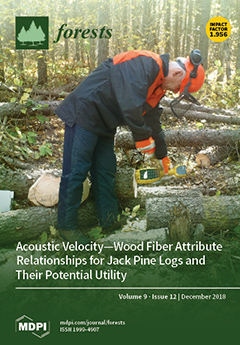We analysed 10 years (2008–2017) of continuous eddy covariance (EC) CO
2 flux measurements of net ecosystem exchange (
NEE) in a young pedunculate oak forest in Croatia. Measured
NEE was gap-filled and partitioned into gross primary productivity (
GPP) and ecosystem reparation (
RECO) using the online tool by Max Planck Institute for Biogeochemistry in Jena, Germany. Annual
NEE,
GPP, and
RECO were correlated with main environmental drivers. Net primary productivity was estimated from EC (
NPPEC), as a sum of −
NEE and
Rh obtained using a constant
Rh:RECO ratio, and from independent periodic biometric measurements (
NPPBM). For comparing the
NPP at the seasonal level, we propose a simple model that aimed at accounting for late-summer and autumn carbon storage in the non-structural carbohydrate pool. Over the study period, Jastrebarsko forest acted as a carbon sink, with an average (±std. dev.) annual
NEE of −319 (±94) gC m
−2 year
−1,
GPP of 1594 (±109) gC m
−2 year
−1, and
RECO of 1275 (±94) gC m
−2 year
−1. Annual
NEE showed high inter-annual variability and poor correlation with annual average global radiation, air temperature, and total precipitation, but significant (
R2 = 0.501,
p = 0.02) correlation with the change in soil water content between May and September. Comparison of annual
NPPEC and
NPPBM showed a good overall agreement (
R2 = 0.463,
p = 0.03), although in all years
NPPBM was lower than
NPPEC, with averages of 680 (±88) gC m
−2 year
−1 and 819 (±89) gC m
−2 year
−1, respectively. Lower values of
NPPBM indicate that fine roots and grasses contributions to
NPP, which were not measured in the study period, could have an important contribution to the overall ecosystem
NPP. At a seasonal level, two
NPP estimates showed differences in their dynamic, but the application of the proposed model greatly improved the agreement in the second part of the growing season. Further research is needed on the respiration partitioning and mechanisms of carbon allocation.
Full article





